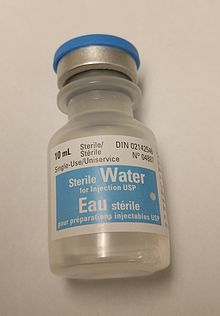|
Water for injection
Water for injection is water of extra high quality without significant contamination.[1] A sterile version is used for making solutions that will be given by injection.[2] Before such use other substances generally must be added to make the solution isotonic.[3] Isotonic solutions containing water for injection can be given by injection into a vein, muscle, or under the skin.[4] A non-sterile version may be used in manufacturing with sterilization occurring later in the production process.[5] Side effects and mechanismsThe primary use of sterile water for injection is as an ingredient for dilution of other medications (aseptic preparation of parenteral solutions).[6] If it is given by injection into a vein without making it approximately isotonic, breakdown of red blood cells may occur.[3] This can then result in kidney problems.[3] Excessive amount may also result in fluid overload.[4] Water for injection is generally made by distillation or reverse osmosis.[5] It should contain less than a mg of elements other than water per 100 ml.[5] Versions with agents that stop bacterial growth are also available.[5] In the UK, some hospitals offer subcutaneous injections of water directly for treating back pain in labour. It is controversial, with some claiming it is pseudoscience.[7] Because sterile water is not isotonic, its injection causes acute pain.[8] One purported mechanism of action is to induce acute local pain to compete directly with diffuse back pain through a mechanism called diffuse noxious inhibitory control; another hypothesis is instead that the acute pain releases endorphins.[8] A review and meta-analysis in 2009 found the benefits of its use inconclusive.[8] History and cultureIt is on the World Health Organization's List of Essential Medicines.[9] Water for injection is available over the counter in the United States.[3] Other namesWater for injection is also known as aqua ad iniectabilia or aqua ad injectionem. References
External links
|
||||||||||||||||||||||
Portal di Ensiklopedia Dunia
